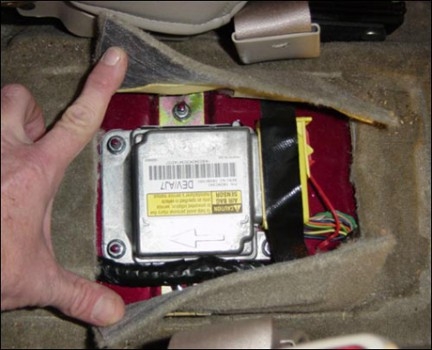
Mandating a Hidden Passenger in Your Automobile
Most people know that any modern aircraft carries a Flight Data Recorder (FDR) or Accident Data Recorder (ADR) as well as a Cockpit Voice Reorder (CVR) and that these two devices are consolidated into what is commonly referred to as a “black box” — despite the fact that it is actually painted bright orange and not black.
The black box is used to continually record the parameters, instrumentation settings and characteristics of an aircraft’s performance. When it is recovered from a crash site, it provides aeronautic experts and crash investigators with an inside look at what may have caused an aircraft to fall out of the sky. However, few people know that a similar electronic device called an Event Data Recorder (EDR) is likely already installed in the automobile that they drive every day and that, if it isn’t, their next new car certainly will have an EDR surreptitiously recording the driver’s actions.
The United States of America’s National Highway Traffic Safety Administration (NHTSA), is the executive branch agency that operates under the auspices of the Department of Transportation and, amongst other things, is tasked with setting and enforcing safety requirements for America’s commercial and consumer road vehicles. It is now putting in place a stringent set of guidelines intended to standardize the continuing implementation and to encourage the expansion of the use of EDRs in passenger vehicles sold in the U.S.A. As of September 1st, 2012, the NHTSA will require that manufacturers producing or selling automobiles in the United States include EDRs capable of recording fifteen different vehicle parameters in their automobiles.

Although different automobile manufacturers have developed a wide variety of types of EDRs with an array of functions and recording parameters, the NHTSA mandate will require fifteen automobile parameters to continually be measured and to be recorded in a retrievable form just prior to a collision or crash. The most important of these fifteen parameters are the following: the vehicle’s longitudinal acceleration; the speed at which the vehicle is traveling when it becomes involved in a collision; the engine’s RPM count at the time of a collision; the position that the throttle is in at the moment of impact; whether or not the brakes were applied immediately before the collision; if and when the automobile’s airbags deployed and, last but not least, whether or not the driver and passengers were wearing seatbelts at the time of the collision. These seven pieces of information (as well as the remaining eight less significant required parameters) are to be recorded by an automobile’s EDR. The purpose of so doing is to help NHTSA authorities, automobile manufacturers, police officials and insurance companies determine why a collision occurred and also who or what — be it a lapse of judgment, careless disregard for traffic laws, mechanical failure or manufacturer’s defect — is responsible for initiating the chain of events that culminated in a collision.
While the use of EDRs to capture and record these parameters is similar to that of the FDRs or ADRs in the aviation industry, the EDR is different from the aviation industry’s black box in a very substantial manner. For instance, the data recorders or black boxes that appear in our automobiles do not include the voice recorder functions that can be found in the black boxes that are tucked away in any passenger aircraft. To include a mandatory and hidden voice recording function in an automobile’s EDR simply to benefit NHTSA authorities, automobile manufacturers, police officials and insurance companies would be a draconian and unconstitutional invasion of privacy cloaked in a thin veil of increased safety.
General Motors was the first major North American automobile manufacturer to place an EDR in its automobiles. It began equipping a limited number of its automobiles with primitive EDRs as early as 1994. Fourteen years ago, in 1998, General Motors began to install, in the majority of its automobiles, a new breed of advanced EDR that was capable of capturing the type of vehicle parameters required by the NHTSA mandate to come into effect on September 1, 2012. The Ford Motor Company followed suit shortly thereafter by beginning to install EDRs in some of its automobiles in 2001 and then, two years later, it began to equip most of its automobiles with advanced EDRs similar to those used by General Motors. Chrysler was the last of the Big Three to implement the use of the EDRs, having begun this task in 2005. Even by 2003, in excess of forty million vehicles were equipped with EDRs of one type or another. In fact, as it currently stands, approximately 90 per cent of new American automobiles are equipped with EDRs. Mercedes Benz (the company that invented the internal combustion automobile) and Audi are among the few manufacturers that have refused to install EDRs in their products. NHTSA estimates peg the costs of equipping the rest of new American cars with EDRs at approximately $24.4 million.

The behavior of Canadian drivers is also being monitored by EDRs on a daily basis due to the fact that, with very few exceptions, the majority of cars driven in Canada are built to meet the same requirements as those sold in the American domestic market. In other words, cars that are built for the U.S. market but sold in both Canada and the U.S. generally have very similar, if not identical, design components. They are built to the same specifications minus differences in instrumentation, lighting and occasionally emissions requirements between the two nations. But where then lies the problem with the increasing presence of EDRs in our automobiles and the NHTSA’s mandate? As when addressing the reasons why voice-recording functions will likely remain indefinitely absent from automobiles equipped with EDRs, the answer to the question is both philosophical and legal-based. The surveillance provided through the use of EDRs can be seen as a type of invasion of privacy that could be harnessed for malicious purposes rather than for the espoused motives of increasing safety for motorists and, to a lesser extent, pedestrians. In fact, data recovered from EDRs has been used by insurance companies to deny claims to customers involved in an accident where the claimant was not legally at fault but where the EDR revealed that the claimant was travelling faster than the speed limit.
Many complicated questions remain difficult to answer: Who has access to the data stored in an automobile’s EDR? Under what circumstances and for what specific purposes? An executive branch agency implementing sweeping mandates intended to observe and collect data on hundreds of millions of its citizens without their knowledge and consent and without providing answers to complicated questions risks being seen as little more than an unprecedented power grab by an increasingly paternalistic government.











